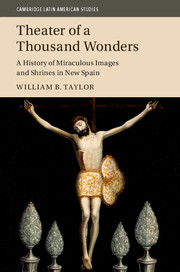Book contents
- Frontmatter
- Dedication
- Contents
- List of Figures
- List of Maps
- List of Tables
- Preface and Acknowledgments
- Archive Abbreviations
- Introduction
- Part I Bearings: Historical Patterns and Places of Image Shrines
- Part II Soundings: Divine Presence, Place, and the Power of Things
- Conclusion
- Appendix 1 Colonial Image Shrines
- Appendix 2 When Shrines Began
- Appendix 3 Other Saints
- Index
Introduction
Published online by Cambridge University Press: 05 September 2016
- Frontmatter
- Dedication
- Contents
- List of Figures
- List of Maps
- List of Tables
- Preface and Acknowledgments
- Archive Abbreviations
- Introduction
- Part I Bearings: Historical Patterns and Places of Image Shrines
- Part II Soundings: Divine Presence, Place, and the Power of Things
- Conclusion
- Appendix 1 Colonial Image Shrines
- Appendix 2 When Shrines Began
- Appendix 3 Other Saints
- Index
Summary
[Living tissue] is constantly replacing itself, even when it seems to stay the same. It is not a thing but a performance.
– Colin TudgeChristian shrines – santuarios – in New Spain were privileged “places of God,” “renowned and miraculous,” that were acclaimed beyond the confines of the local community. Their standing as shrines originated in a “burst of divine presence,” and they remained popular over many years because people believed that extraordinary consolation and favors for the faithful were available there. These shrines typically displayed a statue or painting of Christ or the Virgin Mary that was associated with a founding miracle in which the figure was understood to have come to life in some fashion or suddenly became the site of amazing protection and other wonders. Whether it was in a cathedral, a fine temple, a modest chapel, or on an altar, the shrine was literally a vessel of sacred treasure and place of refuge, meant to welcome, honor, protect, and contain the divine presence that had shown favor there and might do so again as a “theater of a thousand more wonders.”
I have written essays and occasional pieces about various shrines, images associated with miracles, and sacred space in colonial Mexico, but working toward a more comprehensive historical account is a different challenge. What is the narrative line for such a subject, where high politics and warfare do not dominate, the secondary literature is sparse, and many particular places stand out? What is gained and lost in proposing patterns over time from the particulars? The chapters in Part I set out the main lines of change and continuity I noticed from the first years of Spanish colonization and Christian evangelization to the founding of most shrines in the seventeenth century and to their consolidation and expansion in the eighteenth century, pieced together from information about roughly 500 shrines and images. (See Map 1.1 for the location of image shrines discussed in the text.) They offer a perspective on change and a foundation for the later chapters, which turn to the material culture of devotion, miracles, pilgrimage, and some particular images and places in time that bend as much as they punctuate a history of how and why some shrine images came to be more widely known and why most of them remained popular.
- Type
- Chapter
- Information
- Theater of a Thousand WondersA History of Miraculous Images and Shrines in New Spain, pp. 1 - 32Publisher: Cambridge University PressPrint publication year: 2016

